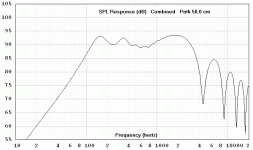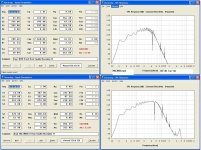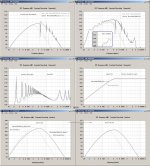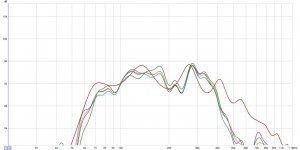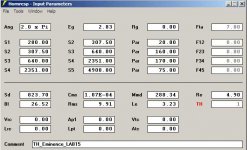Yes, a shelving network is what a CD compensation network is. You can have a high pass or low pass shelving network.
djn, you might want to start a new thread for this instead of keeping it in the hornresp thread since it doesn't really have anything to do with just the software anymore.l
djn, you might want to start a new thread for this instead of keeping it in the hornresp thread since it doesn't really have anything to do with just the software anymore.l
Hello,
For sure a part of the peak could be due to the loudspeakers but as I can see on you pictures (for any reason I cannot enlarge them), the loudspeaker is used as a dipole and thus, there is an interference between the rear wave and the front wave.
Here attached the combined response (front + rear waves) as calculated by Hornresp.
Best regards from Paris, France
Jean-Michel Le Cléac'h
For sure a part of the peak could be due to the loudspeakers but as I can see on you pictures (for any reason I cannot enlarge them), the loudspeaker is used as a dipole and thus, there is an interference between the rear wave and the front wave.
Here attached the combined response (front + rear waves) as calculated by Hornresp.
Best regards from Paris, France
Jean-Michel Le Cléac'h
One more thing, When you said "shelve" do you mean some kind of network that would bring down the highs? Something like a reverse CD comp network for Wave Guide horns?
Also, this being horns, what it help flatten them out to put a back chamber box behind the 126s?
Attachments
OK, looks like these will be actual horns now. I was scratching my head trying to figure out how to bring down the highs and thought that I would try closing off the backs and turn them into true front loaded horns. I had 2 shipping boxes that are 6x6x6" and duct taped them to the back of the driver and Vawala!!! The mid bass is actually just a little bit louder than the highs now.
So my question now is, how do I size the back chamber? Is it a function of the T/S of the driver or the horn geometry or what?
I know how to do it in HR, but would like to understand the theory behind it.
So my question now is, how do I size the back chamber? Is it a function of the T/S of the driver or the horn geometry or what?
I know how to do it in HR, but would like to understand the theory behind it.
Hello, i just found the impulse response spectrogram function. I like it, but i could need some help interpreting the results.
- Is this spectrogram a direct derivative of the frequency response or are there more complicated mechanisms at work? (ie. could i equalize a closed box to a horns frequency response and still get different impulse responses?)
- Different subwoofer types have different impulse spectrums, for example horns have quite a long decay, compared to a closed box. How does the impulse responses spectrum shape/length correlate with the audio quality? (To be honest, i think i cant hear a difference beyond the frequency response...).

- Is this spectrogram a direct derivative of the frequency response or are there more complicated mechanisms at work? (ie. could i equalize a closed box to a horns frequency response and still get different impulse responses?)
- Different subwoofer types have different impulse spectrums, for example horns have quite a long decay, compared to a closed box. How does the impulse responses spectrum shape/length correlate with the audio quality? (To be honest, i think i cant hear a difference beyond the frequency response...).
Hello Mavo,
The spectrogram routine used in Hornresp (and of which I am the author) is a version of my (quasi) wavelets method. The spectrogram is calculated from the pulse response which itself is derived from the module and phase calculated by hornresp.
You may also obtain such spectrogram after exporting the pulse response from Hornresp and using an audio analysis software having such feature.
Best regards from Paris, France
Jean-Michel Le Cléac'h
The spectrogram routine used in Hornresp (and of which I am the author) is a version of my (quasi) wavelets method. The spectrogram is calculated from the pulse response which itself is derived from the module and phase calculated by hornresp.
You may also obtain such spectrogram after exporting the pulse response from Hornresp and using an audio analysis software having such feature.
Best regards from Paris, France
Jean-Michel Le Cléac'h
Hello, i just found the impulse response spectrogram function. I like it, but i could need some help interpreting the results.
- Is this spectrogram a direct derivative of the frequency response or are there more complicated mechanisms at work? (ie. could i equalize a closed box to a horns frequency response and still get different impulse responses?)
- Different subwoofer types have different impulse spectrums, for example horns have quite a long decay, compared to a closed box. How does the impulse responses spectrum shape/length correlate with the audio quality? (To be honest, i think i cant hear a difference beyond the frequency response...).

Hello,
As it results from an integration over a wide time window the amplitude response doesn't render small duration variations as we can see in the spectrogram (e.g.: reflexions from mouth to throat interferring with the direct wave and creating a "tuned pipe"...) effect.
The aim of the spectrogram is an easier analysis of how the sound energy is distributed by the loudspeaker through time after the begining of the pulse. For bass horn it helps to see below which frequency the pulse can be considered as a single pulse and thus it helps the choice of the low-pass crossiver cut-off frequency.
But a one minute explanation of the many would not be enough.
Better for you to read the thread:
http://www.diyaudio.com/forums/multi-way/161627-horn-honk-wanted-44.html
But if you have any question on a precise point I'll be pleased to help.
Best regards from Paris, France
Jean-Michel Le Cléac'h
As it results from an integration over a wide time window the amplitude response doesn't render small duration variations as we can see in the spectrogram (e.g.: reflexions from mouth to throat interferring with the direct wave and creating a "tuned pipe"...) effect.
The aim of the spectrogram is an easier analysis of how the sound energy is distributed by the loudspeaker through time after the begining of the pulse. For bass horn it helps to see below which frequency the pulse can be considered as a single pulse and thus it helps the choice of the low-pass crossiver cut-off frequency.
But a one minute explanation of the many would not be enough.
Better for you to read the thread:
http://www.diyaudio.com/forums/multi-way/161627-horn-honk-wanted-44.html
But if you have any question on a precise point I'll be pleased to help.
Best regards from Paris, France
Jean-Michel Le Cléac'h
Houston I think we have a Problem
I have been recently working on a car subhorn design. The falling response is to complement the rising response in a car environment. Pretty close to the transfer function found in my vehicle.
The figures calculated for the B&C set of drivers seem to make sense as they are a baseline efficiency of 97db/m
The figures for the MCM drivers have me wondering what is going on. I have a driver with a baseline efficiency of 87db. And the resulting 1 watt SPL in Hornresp is almost the same. A horn cannot come up with 20 db of gain.
Or I'm really missing something stupidly simple.
So if it's me I'm all ears. If it is the calculations then ....
Me thinks I have found a problem.
I have a request for the Master McBean.
Is there or has there ever been a request for a rudimentary fold engine? One where we the user could manipulate a segment or so to make a horn folding a little easier.
Maybe I'm asking for two much. But no ask no get right?
Mark
I have been recently working on a car subhorn design. The falling response is to complement the rising response in a car environment. Pretty close to the transfer function found in my vehicle.
The figures calculated for the B&C set of drivers seem to make sense as they are a baseline efficiency of 97db/m
The figures for the MCM drivers have me wondering what is going on. I have a driver with a baseline efficiency of 87db. And the resulting 1 watt SPL in Hornresp is almost the same. A horn cannot come up with 20 db of gain.
Or I'm really missing something stupidly simple.
So if it's me I'm all ears. If it is the calculations then ....
Me thinks I have found a problem.
I have a request for the Master McBean.
Is there or has there ever been a request for a rudimentary fold engine? One where we the user could manipulate a segment or so to make a horn folding a little easier.
Maybe I'm asking for two much. But no ask no get right?
Mark
Attachments
....That can account for a lot right there...
No, I don't think so, have a look at this:
b
Attachments
Hi Mark,
Your MCM example shows two drivers connected in parallel, horn-loaded with a compression ratio of 5.03 : 1 and propagating into eighth-space via a relatively long, very low flaring rate horn - operating conditions quite different to those under which the 87dB single-driver "baseline efficiency" figure would have been obtained. The Hornresp results seem quite reasonable to me .
.
I think that in this case you might be asking just a little too much . Building a useful (and robust) horn fold engine would be a rather challenging task, I expect.
. Building a useful (and robust) horn fold engine would be a rather challenging task, I expect.
Kind regards,
David
The figures for the MCM drivers have me wondering what is going on. I have a driver with a baseline efficiency of 87db.
Your MCM example shows two drivers connected in parallel, horn-loaded with a compression ratio of 5.03 : 1 and propagating into eighth-space via a relatively long, very low flaring rate horn - operating conditions quite different to those under which the 87dB single-driver "baseline efficiency" figure would have been obtained. The Hornresp results seem quite reasonable to me
Is there or has there ever been a request for a rudimentary fold engine? One where we the user could manipulate a segment or so to make a horn folding a little easier. Maybe I'm asking for two much. But no ask no get right?
I think that in this case you might be asking just a little too much
Kind regards,
David
Well thanks for the reply David.
Sometimes I need a bit of a look over the shoulder to check if things are all still working correctly.
I knew that was a real big ask.
But when I asked for the slider in the Horn wizard you went way above and beyond. I still thank you from the bottom of my heart for those little tools. They are my favorite part of the program.
I have been working on some recent designs. I thought that the following would be a good assurance of your programming abilities.
Measured by a colleague of mine :
The red line is the simulation the other lines are live measurements taken indoors 18 inches off of the floor swept sine wave. Not gated.
Mark
Sometimes I need a bit of a look over the shoulder to check if things are all still working correctly.
I knew that was a real big ask.
But when I asked for the slider in the Horn wizard you went way above and beyond. I still thank you from the bottom of my heart for those little tools. They are my favorite part of the program.
I have been working on some recent designs. I thought that the following would be a good assurance of your programming abilities.
Measured by a colleague of mine :
The red line is the simulation the other lines are live measurements taken indoors 18 inches off of the floor swept sine wave. Not gated.
Mark
Attachments
Locking Variables.
Hi David,
As Mark just brought up the Wizard .
.
Would it be possible to add an S4 slider to the Wizard for the tapped horn, or is the slider space completely taken up? Many times when I try to model a tapped horn I find a major improvement by increasing the size of S5 beyond what a standard "straight" taper would call for. Another way for that kind of functionality would be to provide a lock button (or buttons) for the S values as we have right now with the "Horn - S2 Fixed" condition window.
Come to think of it, "Lock Buttons" - or a lock function - similar to the lock function in a spreadsheet (e.g.: right click on a variable and select Lock) on all variables would greatly enhance the functionality, and possibly reduce errors, particularly if the "Lock" is transferred when hitting the Add button.
I also want to join Mark in thanking again for your effort, it is highly appreciated.
Regards,
Hi David,
As Mark just brought up the Wizard
Would it be possible to add an S4 slider to the Wizard for the tapped horn, or is the slider space completely taken up? Many times when I try to model a tapped horn I find a major improvement by increasing the size of S5 beyond what a standard "straight" taper would call for. Another way for that kind of functionality would be to provide a lock button (or buttons) for the S values as we have right now with the "Horn - S2 Fixed" condition window.
Come to think of it, "Lock Buttons" - or a lock function - similar to the lock function in a spreadsheet (e.g.: right click on a variable and select Lock) on all variables would greatly enhance the functionality, and possibly reduce errors, particularly if the "Lock" is transferred when hitting the Add button.
I also want to join Mark in thanking again for your effort, it is highly appreciated.
Regards,
Attachments
The red line is the simulation the other lines are live measurements taken indoors 18 inches off of the floor swept sine wave.
Hi Mark,
Thanks for the thanks, and for posting the "measured vs predicted" comparison results.
Kind regards,
David
Hi Oliver,
Thanks for the thanks, to you also .
.
So far I have managed to resist the temptation to undertake any further development of the Tapped Horn Wizard. The work required to implement enhancements such as you suggest, would be considerable indeed. I am struggling to justify the effort involved, considering the limited benefit to be gained. Nevertheless, I will take on board your comments, and keep them in mind for the future - I am not promising anything, though... .
.
Kind regards,
David
Thanks for the thanks, to you also
Would it be possible to add an S4 slider to the Wizard for the tapped horn?
So far I have managed to resist the temptation to undertake any further development of the Tapped Horn Wizard. The work required to implement enhancements such as you suggest, would be considerable indeed. I am struggling to justify the effort involved, considering the limited benefit to be gained. Nevertheless, I will take on board your comments, and keep them in mind for the future - I am not promising anything, though...
Kind regards,
David
- Home
- Loudspeakers
- Subwoofers
- Hornresp
